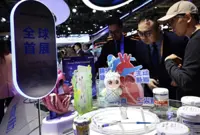The number of journalists and influencers invited to cover the Shanghai auto show from abroad appears to be highest ever.
China’s carmakers are ready with the right technology, designs and prices to dominate in coming decades, and they want the world to know it.
That seems to be why the number of journalists and influencers invited to cover the Shanghai auto show from abroad appears to be highest ever.
Although official figures are hard to come by, corporate events held on the eve of and in the lead up to China’s biggest automobile show included hundreds of reporters packed into luxurious hotel briefing rooms to hear about the latest models being built by BYD Co, Zeekr and other Chinese electric vehicle (EV) manufacturers.
It’s a clear change of attitude in a country known for tight controls over journalist visas.
Notable are the preponderance of reporters from Latin America and the Middle East, reflecting ambitions the carmakers – and more importantly, China – harbour to dominate those regions in EVs as local incomes rise.
Faster expansion abroad will also help alleviate overcapacity in EV manufacturing, with an estimated 17 million in unit sales projected this year versus the ability to assemble 36 million, according to local media reports.
China’s No. 1 selling car brand BYD hosted some 150 journalists and influencers from Latin America who came from as far as El Salvador, Paraguay, Ecuador, Chile and Peru. The lively pack were treated to the luxury hotels in Shanghai that line the Huangpu river overlooking the Bund, including one with rooms going for at least US$375 a night.
The EV market in Latin America is projected to reach US$19bil in sales by 2030, thanks to government incentives and infrastructure expansion, despite existing challenges including limited charging stations.
BYD is building a factory in Brazil with the goal of producing 150,000 vehicles there annually.
MG, owned by China’s SAIC Motor Corp, is setting up a factory in Mexico to cater specifically to the Latin American market.
Influencers are also being given greater access.
With their slickly produced videos and constant social media posts that attract huge numbers of followers, YouTubers and bloggers have outsized ability to shape consumers’ perceptions about the quality and performance of international car brands.
Forrest Jones, a car reviewer with 3.2 million YouTube subscribers, was mingling with the crowd sipping drinks at Zeekr’s media event on the rooftop of the iconic Fairmont Peace Hotel.
Known for his reviews of everything from kei cars to SUVs, Jones’s clips of Chinese EVs have garnered hundreds of thousands of views as he highlights features and designs that can’t be found in North American or European marques.
Jones has little doubt US car buyers will want to buy Chinese EVs once they see their value, if the cars ever make it to the United States.
“They would totally go for it,” Jones said. Chinese automakers by and large don’t sell passenger vehicles in the United States due to punitive tariffs.
The hospitality extended to foreign journalists and influencers hasn’t gone unnoticed by local media.
Zhang, a Chinese influencer who asked to be only identified by his last name, said that many of his peers’ complaints over preferential access to foreign journalists stem from them being overly feted in the past.
“It shouldn’t matter if the Chinese car companies are paying for hotels or transportation,” Zhang said. “Influencers should serve their audience first and help the public make better decisions when buying a car.” — Bloomberg
Reed Stevenson, Danny Lee and Linda Lew write for Bloomberg. The views expressed here are the writers’ own.





